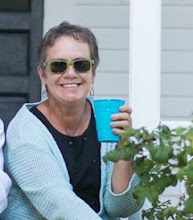The piece above was for the vignette style class. This seemed more intuitive to me than some of the other styles. The vignette is an arrangement of smaller size images, grouped together so there is a "border" around it with no images and at least one of the corners is an empty spot for the eye to rest.
I made this on a canvas that I primed with gesso and painted a soft off-white. I stamped a few images around the edge to add some interest and rubbed some ink around the whole canvas to pick up the color of the stamping.
The bird was rescued from the New York Times Style magazine I blogged about recently. I didn't have any nest image or stamp that would work, so I cut text from an old book and rubbed it with Vintage Photo Distress Ink. Then I cut some small strips from a piece of linen and arranged the strips into a nest of sorts - fun! Here's a closer look:
The eggs came from an old Cavallini catalog; they were much too big, so I trimmed them down so it didn't look like the poor birdie laid ostrich eggs. I added a strip of paper from a wire-bound notebook and threaded a small piece of brown and gold string through the holes.
The background sheet music goes with the bird theme and the striped piece behind that picks up the gold from in the bird. I added the "b"and the red postage stamp to pick red in the bird and keep the eye moving in the piece.
So check out the difference in these two pieces. The one on the left was my first try and Claudine explained that the "b" on the upper left would work better if skooched down just a bit. Now I know the term "bad tangency" - two. lines almost but not quite touching create a tension that draws the eye to that spot and keep it there. The "b" on the left is just barely touching the sheet music - a bad tangency.
I moved the letter down just a bit on the piece on the right, and then moved the postage down a little so the two elements aren't directly across from each other - much better. The "b" bothered me and I asked Claudine about it when I posted this piece. Seems our instinct can tell me something is off - wish it could also tell how to fix it. But now I can be on the lookout for those bad, very bad, tangencies!














Sounds like a great class, I wish I had heard about this. Must has been nice to get direct feedback from Claudine. Very pretty collage.
ReplyDeleteBarb - It was so helpful to get feedback and from such an expert!
DeleteCheck out this site for future classes:
http://www.bigpictureclasses.com/
Claudine may do a Part 2 for the omposition class.
The gathering of the images and textures and objects is surely part of the pleasure of a collage. It's a story in process, I would imagine, in a somewhat different way from a painting or drawing. Closer to an assemblage.
ReplyDeleteAmazing what small adjustments will do to any composition. Sounds like fun, and requiring a great deal of patience.
Collage is much like an assemblage, also like solving a puzzle.
DeleteAs an over-thinker, over-analyzer, need to fix everything type, forcing myself to step back and take a deep breath while making collages is a skill I would like to expand into other areas of my life- ha!